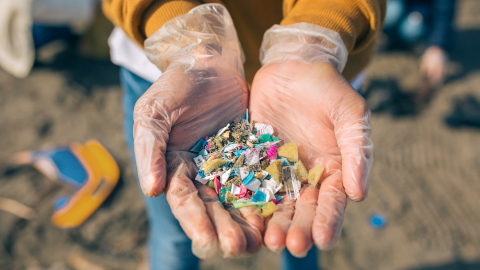Pioneer EU project to investigate micro and nanoplastics impact and consequences on human health

PLASTICHEAL project will develop new methodologies and will provide reliable scientific evidence for regulators to set the knowledge basis for adequate risk assessment. The results will draw a variety of experimental human models and measuring potential health effects under short and long-term conditions.
26/05/2021
Humans are exposed to incidental micro and nanoplastics (MNPLs) due to their ubiquitous presence in the environment, but there is only very limited information on the potential impact of this exposure on human health. Therefore, the current regulatory framework cannot ensure that incidental MNPLs present in the air, and in food and beverage products are at safe levels for the population.
In this context, the European project PLASTICHEAL, coordinated by the Autonomous University of Barcelona (UAB), aims at providing new methodologies and evidence to regulators by combining the use of breakthrough research and reliable test methods to set the knowledge basis for adequate risk assessment of MNPLs.
Innovative approach
The project will first generate human exposure estimates after identification, measurement, and characterization of MNPLs present in the environmental air, water and food sources, as well as in human biological samples of population groups with potential high MNPLs exposure levels.
Then a variety of complementary experimental models and methodologies will be applied to screen for several potential MNPLs-induced effects. In vitro, in vivo and in silico models will be applied to develop a MNPLs predictive toxicology: the combined advanced analytical and computational methods will allow not only to decipher cellular responses or identify critical pathways relevant to key traits or conditions, but also to retrieve a highly informative set of features to predict toxicity.
“We want to study the long-term impact on the general population and also on the most vulnerable groups, not only among the people most exposed to MNPLs, but also among those with health conditions that could make them more vulnerable to potential adverse effects”, explained Ricard Marcos, professor at the Department of Genetics and Microbiology at the UAB and project coordinator.
The data generated will be processed by integrative analysis methods to obtain MNPLs mechanistic insight, and to identify key events with potential to be consolidated as novel biomarkers of MNPLs long-term effects.
Social impact
The ultimate purpose of PLASTICHEAL is to inform regulators in order to provide better protection from plastics exposure to workers, consumers and the environment. The generated risk characterization will contribute to the determination of MNPLs “acceptable” levels for human health. It will also help identifying the main sources of MNPLs human exposure.
A continuous feedback will be established with regulators, NGOs, consumers, general population, and industry involved in the plastic life cycle in order to identify key questions and to ensure societal and regulatory relevance.
The knowledge gained and the methodology developed in PLASTICHEAL will permit the identification and management of safety issues related to human exposure to incidental MNPLs.
PASTICHEAL, which has received 6 million euros of from the European Commission, has the participation of 11 universities and research centres from 7 EU countries, including the UAB: the Wageningen University (The Netherlands), the Finnish Institute of Occupational Health (from Finland), Technical University of Denmark (from Denmark), the French Alternative Energies and Atomic Energy Commission and the National Institute of Health and Medical Research (from France); the Foundation for Health Training and Research of the Region of Murcia, the Germans Trias i Pujol Research Institute (IGTP, as a third part linked to UAB) and the Plastics Technology Centre (from Spain), the University of Manchester (from the United Kingdom), the Helmholtz Centre for Environmental Research and the Leipzig University (from Germany).
Maximizing MNPLs research impact in the EU
PLASTICHEAL, together with AURORA , IMPTOX , PlasticsFatE , and POLYRISK, is one of the five European main research projects currently working to understand micro- and nanoplastics (MNPLs) in our environment and their exposures and impacts on health. These projects are publicly funded under a call within the European Union's Horizon 2020 program. To optimise synergies, these five projects have formed the European Research Cluster to Understand the Health Impacts of Micro- and Nanoplastic (CUSP).
The public launching event of this Cluster, entitled "Science to Policy: Understanding the health risks of micro-and nanoplastics and acting on it" will take place online on June 9th from 14:00 to 16:00.